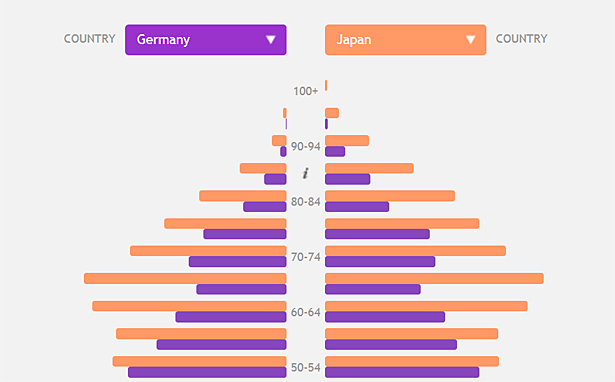Is the same in store for Europe?
The rapid aging process Japan underwent is clearly shown in indicators such as the proportion of elderly to those of working age (the old-age dependency ratio). It becomes even more striking when compared to other countries. PROJECT M’s interactive graph Demographic Insights illustrates the rising number of elderly Japanese, as well as other demographic, pension-related and macroeconomic data.
To put the case of Japan into perspective, one needs only look at France, which took 115 years (1865-1980) to double its proportion of people aged 65 and over – from seven percent to 14 percent. This meant that France, like many other developed nations, had more timeframe to prepare itself for the aging of its society.
A warning for other Asian countries
The rapid aging of Japan’s society serves as a warning as well as offering important insights into the demographic challenge facing other Asian nations. From Turkey to Malaysia, many countries are now aging at a similar pace to Japan’s and so will have less than 25 years to adapt their retirement institutions to meet the needs of an aged rather than an aging society.
But there is no need for gloom. Despite the pressure demographic change exerts on social security systems, aging is an opportunity, says John Beard, director of the Department of Ageing and Life Course at the World Health Organization. “There are 85-year-old people who hold down incredibly high-pressure jobs, are incredibly healthy and basically performing like a 35-year-old.”
Japan’s deteriorating performance in terms of the Allianz Pension Sustainability Index (PSI) is closely linked to its rapid aging. Preliminary results on an update of the PSI (due later this year) show that Japan has declined further in terms of the sustainability of its pension system and is likely to continue to do so in the future.
At the time of the first edition of the PSI in 2009, Japan was ranked 30th, only to drop to 40th in the 2011 edition. The 2014 edition of the PSI will see Japan ranked third to last. An extraordinary debt level of 238 percent of gross domestic product (according to statistics from the International Monetary Fund) further adds to Japan’s woes.
Generous pensions? Unlikely!
Today, the world’s third-largest economy has approximately 42 people aged 65 and older for every 100 people of working age. As early as 2023, its old-age dependency ratio will reach 50 per 100 people of working age – in other words, two Japanese of working age will be supporting one person of retirement age. At such a ratio, promises of relatively generous pension benefits are unlikely to be kept.
Driven by declining fertility rates and increasing life expectancies, the potential problems caused by increased aging in Japan show no signs of abating. At birth, Japanese life expectancy stands close to 87 years for women – four years more than, say, women in the United Kingdom.
On the other hand, at 1.41 children per woman, Japan’s fertility rate is one of the lowest, leading to a 15-percent shrinkage of the Japanese population by 2050.

